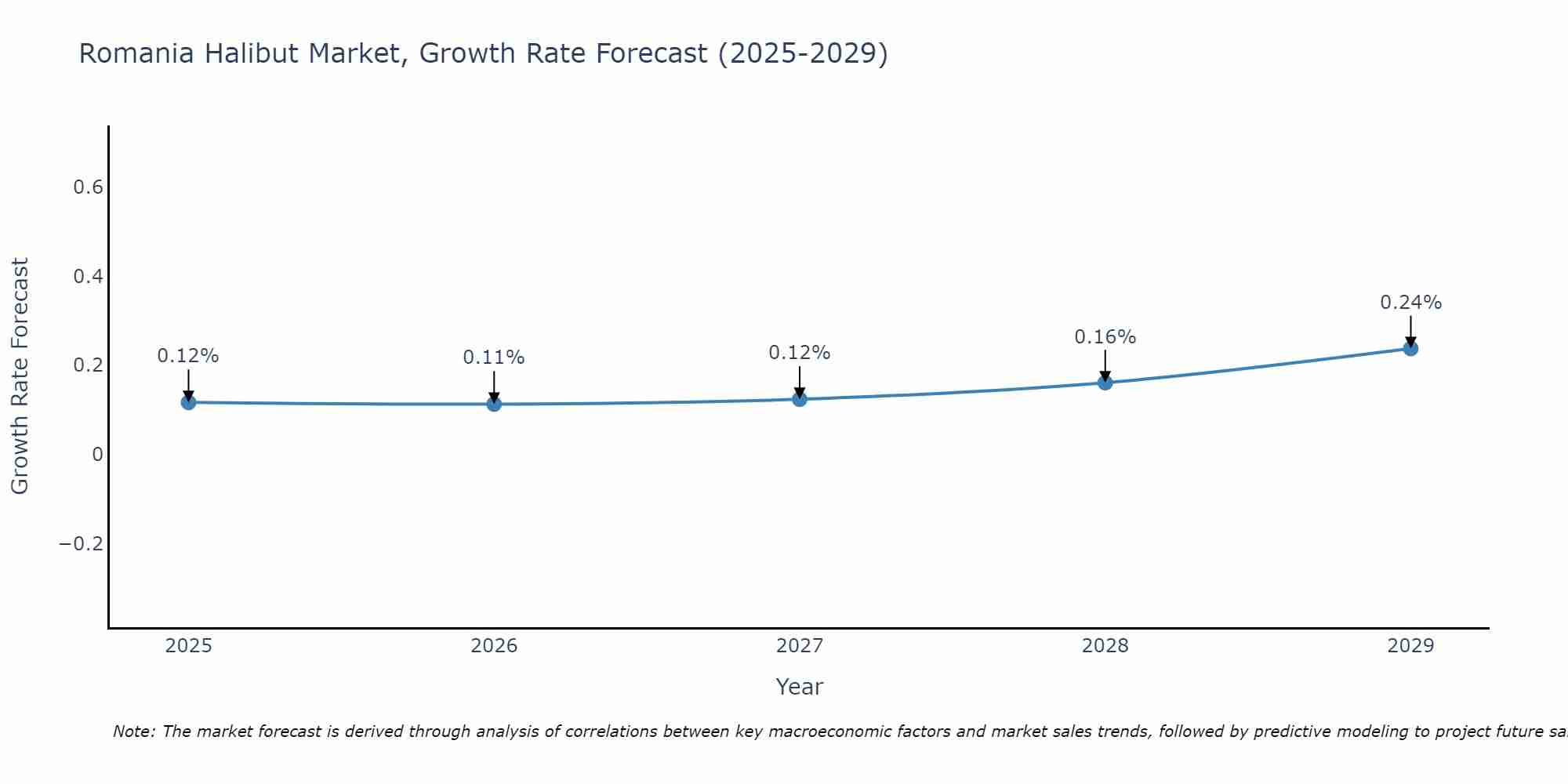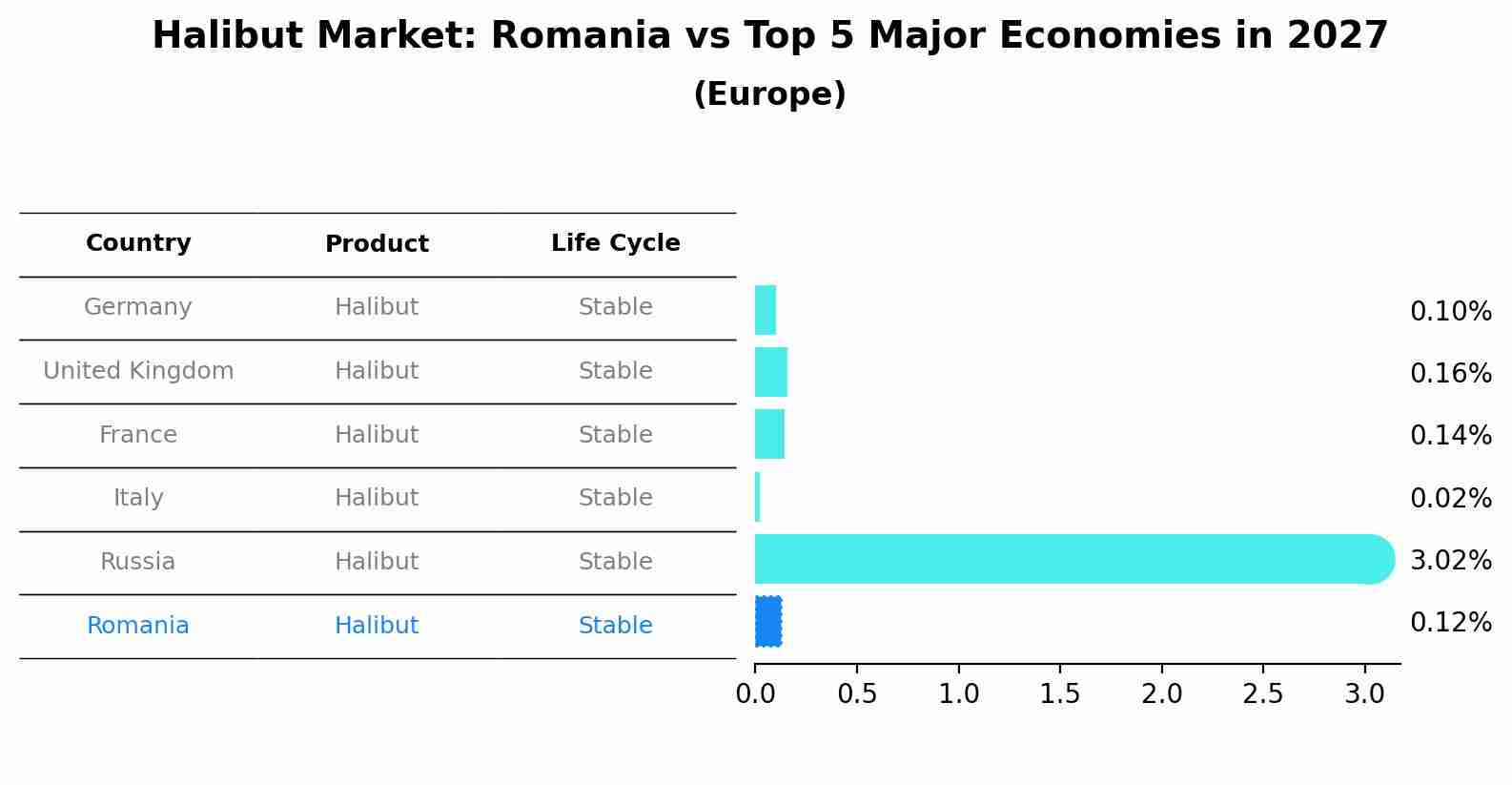Romania Halibut Market (2025-2031) Outlook | Industry, Forecast, Companies, Growth, Trends, Size, Value, Revenue, Analysis, Share
| Product Code: ETC386778 | Publication Date: Aug 2022 | Updated Date: Jul 2025 | Product Type: Market Research Report | |
| Publisher: 6Wresearch | Author: Ravi Bhandari | No. of Pages: 75 | No. of Figures: 35 | No. of Tables: 20 |
Romania Halibut Market Size Growth Rate
The Romania Halibut Market is projected to witness mixed growth rate patterns during 2025 to 2029. Commencing at 0.12% in 2025, growth builds up to 0.24% by 2029.

Halibut Market: Romania vs Top 5 Major Economies in 2027 (Europe)
By 2027, Romania's Halibut market is forecasted to achieve a stable growth rate of 0.12%, with Germany leading the Europe region, followed by United Kingdom, France, Italy and Russia.

Romania Halibut Market Synopsis
The Romania Halibut market is characterized by a growing demand for this popular flatfish species among consumers due to its mild flavor and versatile culinary applications. The market is primarily driven by the increasing awareness of the health benefits associated with consuming halibut, such as being a rich source of protein and omega-3 fatty acids. In Romania, the market for halibut is experiencing steady growth as more restaurants and seafood retailers include it in their offerings to cater to the demand from health-conscious consumers. Additionally, the rise in disposable income levels among the population is also contributing to the growth of the halibut market in Romania. Overall, the Romania Halibut market presents opportunities for suppliers and retailers to capitalize on the growing consumer interest in this premium seafood product.
Romania Halibut Market Trends
In the Romania Halibut Market, there is a growing trend towards sustainable sourcing and ethical practices. Consumers are increasingly seeking out halibut products that are sourced responsibly, with a focus on traceability and transparency in the supply chain. This trend is being driven by a heightened awareness of environmental issues and a desire to support fisheries that prioritize conservation efforts. Additionally, there is a rising demand for premium halibut products, such as organic or wild-caught varieties, as consumers become more discerning about the quality and origin of their seafood. Market players are responding to these trends by emphasizing their sustainable practices and certifications to differentiate their products in the competitive market landscape. Overall, the Romania Halibut Market is witnessing a shift towards sustainability and quality as key driving factors for consumer purchasing decisions.
Romania Halibut Market Challenges
In the Romania Halibut Market, there are several challenges faced by both producers and consumers. One of the main challenges is the limited availability of halibut in the region, leading to high prices and fluctuating supply. Additionally, there may be issues with the quality and freshness of the halibut due to transportation and storage constraints. Another challenge is the competition from other fish varieties that are more readily available and affordable to consumers. Furthermore, there may be regulatory hurdles and strict import/export requirements that impact the overall market dynamics. Overall, navigating these challenges requires strategic planning, efficient logistics, and effective marketing strategies to sustain and grow the halibut market in Romania.
Romania Halibut Market Investment Opportunities
The Romania Halibut Market presents promising investment opportunities due to increasing consumer demand for high-quality seafood products. With a growing preference for healthy and sustainable food options, halibut, known for its mild flavor and versatile culinary applications, has gained popularity among Romanian consumers. Investors can consider opportunities in aquaculture operations to meet the rising demand for locally sourced halibut. Additionally, investing in distribution channels and marketing strategies can help capitalize on the market potential. Collaborating with local fisheries and implementing efficient supply chain management practices can also enhance profitability in the Romania Halibut Market. Overall, the market offers potential for growth and profitability for investors looking to capitalize on the increasing demand for premium seafood products in Romania.
Jordan Agar Market Government Policies
The Romanian government has implemented various policies to regulate the halibut market in the country. These policies primarily focus on sustainable fishing practices, conservation of halibut populations, and ensuring compliance with EU regulations on fishing quotas and sizes. Authorities have set strict guidelines on fishing methods, gear types, and seasonal restrictions to prevent overfishing and protect the halibut stock. Additionally, there are regulations in place to monitor and control the marketing and selling of halibut to ensure quality and traceability. The government also supports research and development initiatives aimed at improving the sustainability of the halibut market in Romania. Overall, these policies aim to promote responsible fishing practices, safeguard halibut populations, and maintain a healthy and sustainable market for this prized seafood in Romania.
Romania Halibut Market Future Outlook
The future outlook for the Romania Halibut Market appears promising as the demand for high-quality seafood continues to grow among consumers. With increasing health-consciousness and a preference for sustainable food sources, halibut, known for its mild flavor and versatile cooking options, is expected to gain popularity in the Romanian market. Moreover, the rising trend of seafood consumption as a source of protein and essential nutrients is likely to drive the demand for halibut further. As the market becomes more competitive with the introduction of innovative products and marketing strategies, Romanian halibut producers and suppliers have the opportunity to capitalize on this growing trend by ensuring product quality, sustainability practices, and effective market positioning. Overall, the future of the Romania Halibut Market seems bright with potential for growth and profitability.
Key Highlights of the Report:
- Romania Halibut Market Outlook
- Market Size of Romania Halibut Market, 2024
- Forecast of Romania Halibut Market, 2031
- Historical Data and Forecast of Romania Halibut Revenues & Volume for the Period 2021 - 2031
- Romania Halibut Market Trend Evolution
- Romania Halibut Market Drivers and Challenges
- Romania Halibut Price Trends
- Romania Halibut Porter's Five Forces
- Romania Halibut Industry Life Cycle
- Historical Data and Forecast of Romania Halibut Market Revenues & Volume By Category for the Period 2021 - 2031
- Historical Data and Forecast of Romania Halibut Market Revenues & Volume By Pacific Halibut for the Period 2021 - 2031
- Historical Data and Forecast of Romania Halibut Market Revenues & Volume By Atlantic Halibut for the Period 2021 - 2031
- Historical Data and Forecast of Romania Halibut Market Revenues & Volume By California Halibut for the Period 2021 - 2031
- Historical Data and Forecast of Romania Halibut Market Revenues & Volume By Alaska Halibut for the Period 2021 - 2031
- Historical Data and Forecast of Romania Halibut Market Revenues & Volume By Distribution Channel for the Period 2021 - 2031
- Historical Data and Forecast of Romania Halibut Market Revenues & Volume By Store Based for the Period 2021 - 2031
- Historical Data and Forecast of Romania Halibut Market Revenues & Volume By Non Stored Based for the Period 2021 - 2031
- Historical Data and Forecast of Romania Halibut Market Revenues & Volume By Others for the Period 2021 - 2031
- Historical Data and Forecast of Romania Halibut Market Revenues & Volume By End User for the Period 2021 - 2031
- Historical Data and Forecast of Romania Halibut Market Revenues & Volume By Restaurants for the Period 2021 - 2031
- Historical Data and Forecast of Romania Halibut Market Revenues & Volume By Personal for the Period 2021 - 2031
- Historical Data and Forecast of Romania Halibut Market Revenues & Volume By Others for the Period 2021 - 2031
- Romania Halibut Import Export Trade Statistics
- Market Opportunity Assessment By Category
- Market Opportunity Assessment By Distribution Channel
- Market Opportunity Assessment By End User
- Romania Halibut Top Companies Market Share
- Romania Halibut Competitive Benchmarking By Technical and Operational Parameters
- Romania Halibut Company Profiles
- Romania Halibut Key Strategic Recommendations
Frequently Asked Questions About the Market Study (FAQs):
- Single User License$ 1,995
- Department License$ 2,400
- Site License$ 3,120
- Global License$ 3,795
Search
Related Reports
- Portugal Electronic Document Management Market (2025-2031) | Strategy, Consumer Insights, Analysis, Investment Trends, Opportunities, Growth, Size, Share, Industry, Revenue, Segments, Value, Segmentation, Supply, Forecast, Restraints, Outlook, Competition, Drivers, Trends, Demand, Pricing Analysis, Competitive, Strategic Insights, Companies, Challenges
- France Electronic Document Management Market (2025-2031) | Strategy, Consumer Insights, Analysis, Investment Trends, Opportunities, Growth, Size, Share, Industry, Revenue, Segments, Value, Segmentation, Supply, Forecast, Restraints, Outlook, Competition, Drivers, Trends, Demand, Pricing Analysis, Competitive, Strategic Insights, Companies, Challenges
- Portugal Occupational Health & Safety Services Market (2025-2031) | Strategy, Consumer Insights, Analysis, Investment Trends, Opportunities, Growth, Size, Share, Industry, Revenue, Segments, Value, Segmentation, Supply, Forecast, Restraints, Outlook, Competition, Drivers, Trends, Demand, Pricing Analysis, Competitive, Strategic Insights, Companies, Challenges
- Netherlands Occupational Health and Safety Services Market (2025-2031) | Strategy, Consumer Insights, Analysis, Investment Trends, Opportunities, Growth, Size, Share, Industry, Revenue, Segments, Value, Segmentation, Supply, Forecast, Restraints, Outlook, Competition, Drivers, Trends, Demand, Pricing Analysis, Competitive, Strategic Insights, Companies, Challenges
- Belgium and Luxembourg Facility Management Market (2025-2031) | Strategy, Consumer Insights, Analysis, Investment Trends, Opportunities, Growth, Size, Share, Industry, Revenue, Segments, Value, Segmentation, Supply, Forecast, Restraints, Outlook, Competition, Drivers, Trends, Demand, Pricing Analysis, Competitive, Strategic Insights, Companies, Challenges
- Russia Women Intimate Apparel Market (2025-2031) | Strategy, Consumer Insights, Analysis, Investment Trends, Opportunities, Growth, Size, Share, Industry, Revenue, Segments, Value, Segmentation, Supply, Forecast, Restraints, Outlook, Competition, Drivers, Trends, Demand, Pricing Analysis, Competitive, Strategic Insights, Companies, Challenges
- Africa Chocolate Market (2025-2031) | Size, Share, Trends, Growth, Revenue, Analysis, Forecast, industry & Outlook
- Global Hydroxychloroquine And Chloroquine Market (2025-2031) | Industry, Trends, Size, Outlook, Growth, Value, Companies, Revenue, Analysis, Share, Forecast
- Saudi Arabia Plant Maintenance Market (2025-2031) | Industry, Size, Growth, Revenue, Value, Companies, Forecast, Analysis, Share & Trends
- Taiwan Electric Truck Market (2025-2031) | Outlook, Industry, Revenue, Size, Forecast, Growth, Analysis, Share, Companies, Value & Trends
Industry Events and Analyst Meet
Our Clients
Whitepaper
- Middle East & Africa Commercial Security Market Click here to view more.
- Middle East & Africa Fire Safety Systems & Equipment Market Click here to view more.
- GCC Drone Market Click here to view more.
- Middle East Lighting Fixture Market Click here to view more.
- GCC Physical & Perimeter Security Market Click here to view more.
6WResearch In News
- Doha a strategic location for EV manufacturing hub: IPA Qatar
- Demand for luxury TVs surging in the GCC, says Samsung
- Empowering Growth: The Thriving Journey of Bangladesh’s Cable Industry
- Demand for luxury TVs surging in the GCC, says Samsung
- Video call with a traditional healer? Once unthinkable, it’s now common in South Africa
- Intelligent Buildings To Smooth GCC’s Path To Net Zero













